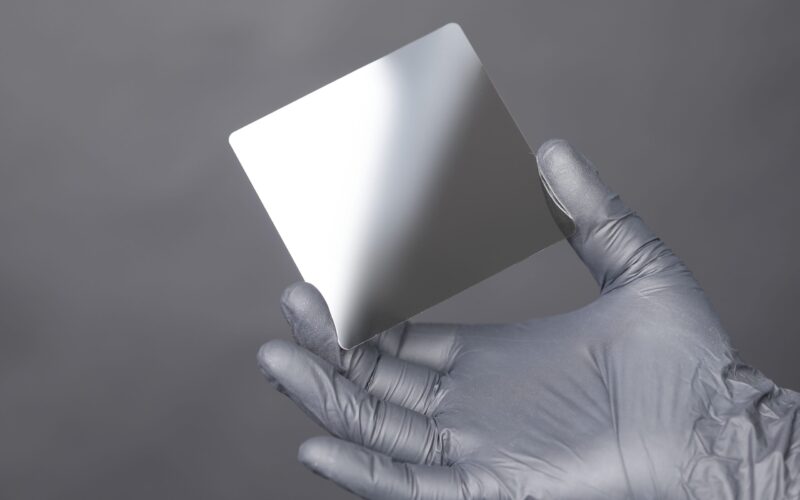The “grey ceramic” storage medium (Image courtesy Cerabyte)
A German startup named Cerabyte is hoping to solve the burgeoning market for secondary and archival data storage with a novel approach that uses lasers to etch bits onto glass with a ceramic coating. The “grey ceramic” technology delivers an affordable and long-lasting storage solution that’s essentially permanent, says the company, which just opened two offices in the United States.
“A data tsunami is on the horizon–and new, trail-blazing approaches to data storage are needed to meet the looming scalability and economic requirements,” said Cerabyte CEO and co-founder Christian Pflaum said in a press release today. “Our vision is to achieve $1 per petabyte per month, a cost reduction of 1000x within the next two decades.”
Hard-disk drives (HDDs) currently store about 85% of the world’s digital data, and about 60% of secondary storage data is stored on HDDs, according to Fred Moore, founder of Horison LLC, who wrote a white paper on behalf of Cerabyte. While the COVID-19 pandemic generated a temporary surplus of HDDs, thus depressing of HDD-based storage costs, that surplus will eventually dissipate, leaving the world wanting a more economic storage medium to handle the existing data tsunami–a Datanami, if you will.
“Current data growth projections of ~25% annually suggest a doubling of data stored every three years,” Moore writes. “Without a new storage solution to effectively manage and contain Zettabyte era demands, HDDs and magnetic tape will continue to compete indefinitely for the enormous secondary storage opportunity with neither solution being ideal.”
Cerabyte was founded in 2000 to deliver a more economic and long-lasting storage medium than tape. The Munich-based company has patented its technology, which involves using a laser to etch encoded binary data onto thin sheets of glass that have been coated with a microscopic layer of ceramic that’s 500 to 1,000 atoms thick. The company used only commercial off-the-shelf components in developing its system.
The company describes its Ceramic Nano Memory technology here:
“The writing process is using ultra-short laser pulses in combination with off the shelf digital mirror devices (DMD) which is commonly used in video projectors and head-up displays. The combination of the laser with a DMD generates a laser beam matrix which permanently ablates the ceramic nano-layer and writes up to 2 million bits per pulse in parallel at high repetition-rates in the kHz range. This enables future writing speeds of 1+ GB/s with less than 1 W average power which is 3-4 times faster compared to LTO tape or HDD technology.”
The reading process, meanwhile, uses the same DMD device paired with a high-resolution image sensor capable of reading more than 500 frames per second. The data is decoded using a Field Programmable Gate Array (FPGA).
Once written, the glass-ceramic plates are resistant to many environmental threats, including floods, fire (up to 930 degrees Fahrenheit), and electrical surges. Compared to a five-year lifespan for HDDs and a 30- to 50-year lifespan for LTO tape cartridges, Cerabyte’s ceramic media is projected to last 1,000 years or more, according to Moore.
The ceramic-coated storage medium will be stacked into a cartridge, while a piezo-driven reading head is used to scan the data, thereby enabling random access. Robotics will move the cartridges within a library, similar to how tape libraries work. This system is being designed for write once, read many (WORM) and write once, read seldom (WORSe) use cases across a range of data-intensive industries, including banking, insurance, media and entertainment, healthcare, science, business, government, and consumer.
The technology is still in development and Cerabyte has built just one demonstration system to date. That system features a single write and read head unit, and was slated to achieve 100 MB/s read and write speeds, and a storage capacity of 1PB per rack, according to Moore.
The Cerabyte roadmap calls for the first enterprise system capable of writing and reading data at 500 MB/s with capacities of 5 PB per rack available in 2025, with bigger storage systems for cloud data centers the following year. By the end of the decade, the company plans to have systems able to move data at 2 GB/s with a capacity of up to 100 PB per industry-standard rack.
The cloud giants, of course, are big users and tape, which enables them to store vast quantities of archival data at very low cost. Researchers at IBM, HP, and Quantum, which are members of the LTO Consortium, have driven large efficiency gains in the tape medium over the past 20 years. However, researchers may be reaching the limits of what magnetic tape can do, and the LTO Consortium has rolled back some of the storage density and speed goals that it set in earlier roadmaps.
If Cerabyte actually can deliver on its lofty goals, then tape may have finally met its match. There are, of course, many hurdles to overcome in the meantime, and we’re reminded about the fate that met other once-promising long-term storage technologies, such as the Blu-ray disc, which 20 years ago was positioned to be the long-term storage medium of the future. Since then, researchers have tried to cram data into all sorts of other mediums, including dye, DNA, and even gold, but none have panned out yet.
Clearly, the upside to reducing the cost of long-term data storage is tremendous, and is enough to justify the R&D expense that firms like Cerabyte are willing to spend to find alternatives. As big data gets bigger into the future, existing storage mechanisms will become too small, too slow, and too expensive to support continued expansion. The big question is figuring out how we will be storing our massive data sets in 50 years, and working toward that goal.
Related Items:
Harvard’s New Data Storage Is to Dye For, Avoids DNA Storage Pitfalls
The Next Breakthrough in Long-Term Data Storage is….Gold?
Three Surprising Ways Archiving Data Can Save Serious Money
Source link
lol



